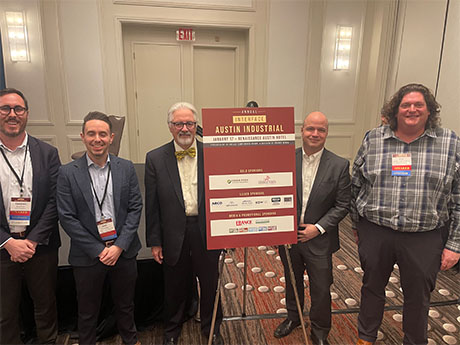By Taylor Williams The multifamily markets of Austin and San Antonio — two of the fastest-growing cities in the country over the last decade — are on pace to deliver above-average volumes of new apartments in 2024, causing some industry experts to express concerns of potential oversupply. The origins of oversupply are not hard to trace, assuming the average apartment project in those markets takes about four years to complete from the time the site is identified and the entitlement and permitting processes begin to when the property is stabilized. Call it five years for some projects that experienced delays due to COVID-19. But in either case, the current wave of new product was largely financed at historically low interest rates at a time when healthy rent growth was easily underwritten. Demand was there, so developers supplied. And for similar reasons, the distress should be short-lived. With interest rates having risen by 400-plus basis points over the last two years and cuts for 2024 looking increasingly less likely, 2025 should be a year of very few new construction starts. Many owners that are delivering product this year will want to allow time for excess supply to be absorbed and see …
Texas Market Reports
By Brett Merz, senior vice president of asset management, KBS Texas was one of the first states to experience the return of employees to the office post-pandemic. That trend continues today. Even as work-from-home and hybrid work become further entrenched in some parts of the country, Texas still leads the nation in terms of employees coming into the office. According to Kastle’s Workplace Barometer, office properties in Dallas, Houston and Austin have occupancy rates during peak times that are 10 percent higher than the national average. Kastle’s data cuts across all building classes, but in our experience, mid-week occupancy at our Class A office properties in Texas is even stronger. Kastle’s data and our experience contrast with the negativity surrounding the office market and point to the potential for greater opportunity throughout 2024 and beyond. According to JLL’s local market office reports for major Texas cities, vacancy rate increases are slowing down. With new construction in Dallas and Austin trending down, as well as zero new construction in San Antonio and Houston, occupancy rates may begin to grow through the rest of the year. Additionally, rents for Class A buildings are either stable or have seen slight increases over the …
The more things change, the more they stay the same. More than 150 years after the old French proverb was coined, industrial real estate professionals in Texas who have a penchant for philosophy may well be seeing its application play out in real time. While the industrial market has cooled from 2021 and early 2022, when insatiable demand drove record rent growth, there are still enough positive fundamentals within the space to counteract the likes of inflation, interest rate hikes and geopolitical uncertainty during an election year. Against that backdrop, owners and brokers are frequently reminded of how fortunate they are to be doing business in the Lone Star State. Muchos Gracias Job and population growth are the Letterman guests who need no introduction, as they have always driven expansion and value creation in Texas across all sects of commercial real estate. But as powerful as those drivers are, they’ve been there all along. In recent years, as disruption in debt markets has slowed industrial supply growth and inflation has put pressure on tenants’ costs of occupancy, other macro-level forces have also emerged to buoy the market. Specifically, the impacts of a growing concentration of manufacturing operations in Mexico have …
Historically, the fortunes of many commercial real estate endeavors in Houston have been tied to the energy sector. But as developers and leasing agents across all major property types know, the market now boasts a much more diverse set of growth drivers, including regional distribution, healthcare, aerospace/defense and financial services. Each of these industries fuels growth in development and absorption of commercial space, not to mention housing. Yet even to the layman, these industries are as different as the commercial structures that house their operations. And taken collectively, the performances of Houston’s commercial properties do not always paint a wholistic picture of the larger economy. That holds especially true in times of larger macroeconomic disruption like the present. Texas Real Estate Business recently reached out to developers/owners, as well as leasing agents/managers who are deeply immersed in the Houston multifamily, industrial, retail, office and mixed-use sectors. By posing a quintet of questions that are — almost — equally applicable to each of these asset classes, we uncover insights on how the five major food groups are performing on a relative basis. Participating in the Q&A are Matt Bronstein, vice president at BHW Capital (multifamily); Robert Clay, president and co-founder of …
Economic development is, in many ways, the business of facilitating growth. Yet in Texas, thanks to an array of business- and development-friendly policies and laws, influxes of jobs, people and new real estate projects to support them sometimes seem to just happen naturally. When this kind of heavy growth is sustained over time, it can lead to less-affordable housing, more cookie-cutter retail scenes and heavier congestion and pressure on local infrastructure. But it is possible for smaller municipalities to embrace job and population growth with new real estate uses and projects in ways that don’t entirely compromise the historic charm or tranquility that many residents of these cities value. Revitalizing a downtown area — bringing in new businesses, adaptively reusing older buildings, creating pedestrian-friendly networks — is a primary means of marrying those objectives. When a successful downtown revitalization program is executed, the benefits tend to have a domino effect. Elevated foot traffic boosts sales at local businesses, increasing asset values over time and stimulating sales of properties. Other investors take note of the viable business plan, and the rest becomes history. But the whole process often starts with the visions of local business owners and the willingness of local …
By J. Wickam Zimmerman, CEO, Outside The Lines Inc. The use of artificial intelligence (AI) technology is growing in retail commerce, where it’s already helping businesses track inventory, forecast demand and suggest new products to consumers. But how does AI figure into retail real estate? Can it be used to enhance engagement and drive success at the properties themselves? Could it help entice shoppers to step away from their online shopping carts and venture out into the real world? The answer is a resounding yes, and we’re already seeing this play out in the Lone Star State. Creating Spaces That Attract & Retain With major Texas markets like Dallas-Fort Worth and San Antonio seeing record-high retail occupancy rates, many property owners are focused on capitalizing on this momentum. To keep foot traffic high and remain competitive with other local developments and online shopping, it’s more important than ever to create unique draws to centers. A key strategy involves creative placemaking and offering experiential destinations that are increasingly bolstered by technology, including AI. To stay ahead, retail centers today must offer an experience that can’t be replicated virtually. This requires having dynamic, interactive onsite features and leveraging technologies that are just …
By Taylor Williams When it comes to industrial supply growth in Central Texas, the usual suspects — land availability, interest rate movement, time-consuming permitting and approval processes — are all secondary to the need for more infrastructural development to support these projects. Roadways, public transit systems, electrical capacity, sewerage and water services — these are the key ingredients in the recipe for successful industrial development in Central Texas that can sometimes be overlooked or understated in importance. As such, economic development corporations (EDCs) in the area are prioritizing infrastructure development in their work as they help developers add much-needed industrial space to support the area’s burgeoning population. While underlying, efficient infrastructure is critical to all real estate developments and human occupation, it is especially crucial to industrial projects. Large-scale manufacturing facilities — think Tesla in East Austin and Samsung in its northern suburb of Taylor — employ thousands of people. Housing hasn’t caught up to population growth in many of the surrounding communities, necessitating alternate means of commuting. In addition, manufacturing and e-commerce facilities tend to have above-average electrical capacity requirements. Financially, meeting that demand might be made somewhat easier in a state that has a deregulated power grid, but logistically, …
InterFace Panel: Macroeconomic, Institutional Market Obstacles Hinder Retail Supply Growth in Austin
By Taylor Williams The Austin retail market is in dire need of more quality space, but between the newfound volatility in the U.S. capital markets and longstanding local policies that have hamstrung commercial developers in the state capital, delivering that space is no easy feat. The city’s remarkable growth story is well-documented. Big Tech has made Austin its home away from home, spearheading what was a 33 percent increase in population between 2010 and 2020, according to the Austin Chamber of Commerce. But the paces of growth of housing and infrastructure — two crucial prerequisites for retail development — haven’t kept up with the surging head count. In addition, the Austin bureaucracy is notorious for slow-moving entitlement and permitting processes, at least in the eyes of Texas developers who have done business in zone-free Houston or certain municipalities of Dallas-Fort Worth that make it a point to fast-track new projects. These issues at the local level have merged with debt market disruption on the national circuit, rendering a scenario in which the process of financing and building new retail space is fraught with headaches, delays and pitfalls. The number of ways in which new projects can be killed in action …
By Taylor Williams For the last several years, as COVID-19, inflation and interest rate hikes have chronologically rocked the commercial real estate industry, the term “dry powder” has increasingly factored into investment discussions. While the term generally refers to cash or capital that is parked on the sidelines, 2024 could well be the year for its deployment. There are several basic reasons for endorsing this notion. First, at its December meeting, the Federal Reserve signaled that it would cut rates three times this year, which should theoretically make debt financing more accessible and less expensive — though the extent of that depends on the magnitude of the reductions. Second, as evidenced by the stock market tear following that announcement, investors are itching to deploy capital and will rally around just about any reason to do so, proven or not. Third, there is roughly $537 billion in commercial real estate loans that will mature next year, according to New York City-based Trepp. This staggering volume of impending maturities in a high-interest-rate environment all but assures that some assets will be forced into sales, whether by owners pre-default or lenders post-default. And finally, the 10-year Treasury yield — the benchmark rate against …
By Taylor Williams The Houston industrial market has generally performed quite well over the past few years, even as a global pandemic, record inflation and hard-hitting interest rate hikes have rocked the commercial real estate industry as a whole. Demand for industrial space has held firm due to rebounding energy prices and expansions in infrastructure and traffic at Port Houston, as well as organic population growth and economic diversification that has elevated the market’s role as a distribution hub. According to data from CBRE, the market has a 6 percent vacancy rate and posted 5.1 million square feet of positive net absorption through the first three quarters of 2023. The volume of new construction was on track to outpace absorption in 2023 when the report was released. But that was not the case in 2021 and 2022, years in which net absorption equaled and exceeded 7 million square feet, respectively. New deliveries totaled approximately 5.6 million and 5.4 million square feet in each of those years, driven not only by the aforementioned factors but also by a temporary uptick in demand for e-commerce services in the wake of the pandemic. In any market or asset class, when absorption exceeds supply …











